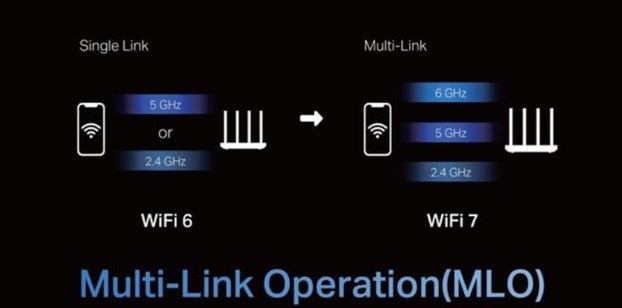Mesh network technology has been widely adopted in smart homes, enterprise networks, and industrial IoT environments. As Qualcomm’s latest flagship WiFi 7 SoC, IPQ9574 excels in performance, connectivity stability, and intelligent management, making it particularly suitable for high-performance Mesh network architectures. This article will comprehensively analyze the advantages of IPQ9574 in WiFi 7 Mesh networks in terms of network performance, topology flexibility, intelligent management, compatibility, and power efficiency. Additionally, we will highlight that this solution requires custom development by customers to adapt to specific application requirements.
2. Key Advantages of Qualcomm IPQ9574 in Mesh Networks
2.1 WiFi 7 Enhancements to Mesh Network Performance
WiFi 7 introduces significant technological advancements that improve the throughput, latency, and interference resistance of Mesh networks:
320MHz Ultra-Wide Channel: Compared to WiFi 6’s 160MHz channel, WiFi 7 supports 320MHz channels in the 6GHz band, significantly increasing backhaul bandwidth and reducing congestion between Mesh nodes.
4K QAM Modulation: Supporting 4096-QAM, which provides a 20% data rate increase over WiFi 6’s 1024-QAM, enhancing high-speed data transmission between Mesh devices.
Multi-Link Operation (MLO): Enables simultaneous multi-band data transmission (2.4GHz, 5GHz, 6GHz), dynamically selecting the best frequency band between Mesh nodes to improve link stability and reduce congestion.

2.2 High Computing Power for Efficient Mesh Network Scheduling
The IPQ9574 integrates a quad-core Cortex-A73 CPU, providing powerful processing capabilities for traffic management and Quality of Service (QoS) optimization in Mesh networks.
Low-Latency Path Optimization: With WiFi 7’s MLO technology, IPQ9574 can intelligently select the lowest latency path, improving network response times.
Intelligent Traffic Distribution: Utilizes dynamic traffic management and AI algorithms to optimize data flow in Mesh networks, reducing packet loss and congestion.
2.3 Flexible Mesh Topology for Large-Scale Deployment
Supports Star, Chain, and Full-Mesh Topologies: Suitable for home, enterprise, and outdoor coverage scenarios, allowing flexible network adjustments based on specific application needs.
Enhanced Backhaul Connectivity: WiFi 7’s MLO technology supports dual-band/triple-band backhaul, improving communication efficiency between Mesh nodes and reducing single-link congestion risks.
Seamless Roaming with Adaptive Signal Switching: IPQ9574 supports advanced BSS coloring and OFDMA technology, enabling devices to switch to stronger signals quickly for uninterrupted roaming.
2.4 High Compatibility for Various Applications
Backward Compatible with WiFi 6/6E/5: The Mesh network can support both WiFi 7 and legacy devices, allowing performance improvements without requiring a complete upgrade of client devices.
Supports OpenWRT/OpenWiFi Solutions: Suitable for enterprise and operator-grade Mesh deployments, providing flexibility for customization and expansion.
Industrial-Grade Support: Some variants of IPQ9574 offer industrial-grade reliability and temperature resistance, making it ideal for outdoor Mesh networks in smart cities and industrial IoT applications.
2.5 Power Efficiency Optimization
TWT (Target Wake Time) Optimization: Supports WiFi 7’s TWT mechanism, enabling IoT devices in Mesh networks to enter low-power sleep mode and wake up only when needed, extending battery life.
Dynamic Power Management: Adjusts signal transmission power intelligently to minimize unnecessary energy consumption, making it suitable for large-scale Mesh networks with power-saving needs.
3. Requires Custom Development by Customers
While IPQ9574 offers powerful WiFi 7 Mesh networking capabilities, it is not a plug-and-play solution. Customers must develop their own software and hardware optimizations to fit their specific use cases, including:
Mesh Protocol Development & Optimization: Qualcomm provides a basic SDK, but customers must customize OpenWRT/OpenWiFi or proprietary firmware to enhance Mesh stability and performance.
Network Management System (NMS) Integration: Enterprises and operators must develop their own network management platforms for remote monitoring, device status tracking, and traffic management.
Hardware Adaptation & Optimization: Depending on the application (home, enterprise, industrial), customers need to design antenna configurations, RF optimizations, and thermal management solutions to ensure optimal performance.
Security Enhancements: While WiFi 7 supports WPA3 security, customers must implement additional enterprise-grade security measures (such as VPN, ACL access control, and device isolation) to meet specific requirements.
4. Conclusion
As Qualcomm’s flagship WiFi 7 SoC, IPQ9574 demonstrates outstanding performance and advantages in Mesh network architectures:
✅ 320MHz Channels + 4K QAM improve throughput and reduce congestion.
✅ MLO Multi-Link Operation provides intelligent frequency switching for enhanced stability.
✅ Quad-Core Cortex-A73 CPU enables efficient traffic scheduling and QoS optimization.
✅ Flexible Topology Support + Intelligent Backhaul Connectivity adapts to various deployment scenarios.
✅ Backward Compatibility with WiFi 6/5, OpenWRT/OpenWiFi Support for easier expansion.
✅ TWT + Smart Power Management optimizes energy efficiency and extends device battery life.
✅ Requires Custom Development to tailor Mesh networking features to specific business needs.
Overall, IPQ9574’s implementation in Mesh networks significantly enhances WiFi 7’s stability, throughput, and intelligent management capabilities, providing a strong wireless connectivity foundation for smart homes, enterprise WiFi, and industrial IoT applications. However, customers must independently develop Mesh protocols, system integration, and optimization solutions to ensure the best performance in their specific use cases.

Comments
Post a Comment